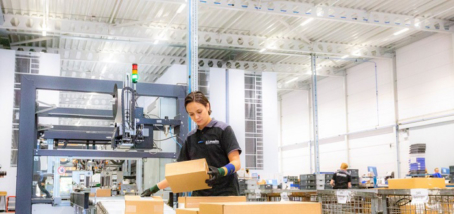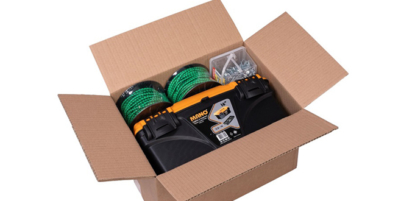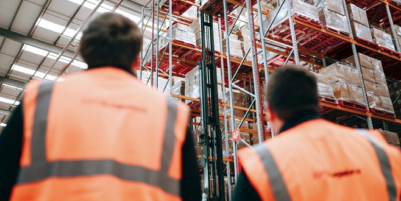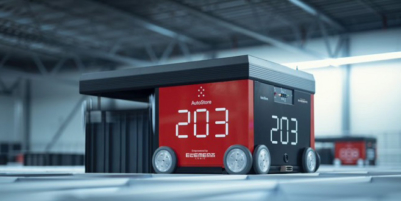-
ROSSLARE EUROPORT TARGETS HEALTH & SAFETY WITH CAMERA TELEMATICS PARTNERSHIP - 2 days ago
-
Landmark Study Reveals Wearable Robotics Significantly Boost Safety and Efficiency in Industrial Environments - July 24, 2024
-
Visku Tackle The Retail Seasonality Challenge One Pallet At A Time - July 22, 2024
-
KAMMAC AND BERGEN LOGISTICS STRENGTHEN FASHION & LIFESTYLE SERVICES IN THE UK - July 19, 2024
-
TENTBOX EXTENDS PARTNERSHIP WITH ARROWXL TO SUPPORT INCREASING DEMAND - July 17, 2024
-
The Perfume Shop improves customer journeys while driving profitability in partnership with Scurri - July 17, 2024
-
ZEROMISSION SECURES £2.3M ($3M) INVESTMENT TO ACCELERATE ELECTRIC FLEETS - July 16, 2024
-
BCMPA CELEBRATES SUCCESS OF 2024 CONFERENCE - July 15, 2024
-
Best of the Best: Jungheinrich Celebrates Triple International Award Win - July 12, 2024
-
GOPLASTICPALLETS.COM CALLS ON NEW CHANCELLOR RACHEL REEVES TO CONSIDER PLASTIC PACKAGING TAX REFORM - July 10, 2024
Forthcoming packaging and waste regulations add to pressures for greater ecommerce packing efficiency
The cardboard supply market is under stress, and forthcoming changes to the regime around packaging and waste will have further impacts. Retailers and shippers will need to act now to optimise their use of an increasingly valuable commodity. By Jo Bradley, Business Development Manager for Packaging Solutions at Quadient.
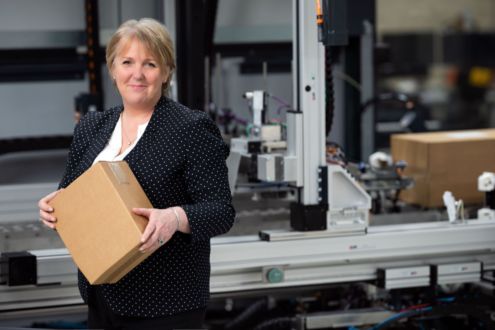
As is well known, on-line sales, most of which are shipped in cardboard boxes, rose 74% year-on-year in 2020. The Confederation of the Paper Industries says the increase represents what had been expected for the next five years – an extra 200 million packages in the postal and courier systems, according to Royal Mail.
Covid restrictions have constrained production, and while extra mill capacity is coming on stream around Europe, it’s thought much of this is going to China and the Far East. Some 84% of European board is made from recycled fibre, but this raises other issues around availability of recyclable material.
Unsurprisingly, all this is having a massive impact on price and availability. In the early part of the year some buyers were reportedly paying £70-£160 over Autumn prices for container board, while lead times were stretched from 48-72 hours to 6 weeks.
But, critically, two separate developments in packaging waste regulations will put further permanent pressure on the board market.
The first of these, to be implemented from 1 April 2022, is a new Plastic Packaging Tax, of £200 per tonne on all plastic packaging materials made or imported to the UK that contain less than 30% recyclate. Since 44% of the UK’s plastic usage is in packaging, this drive to replace new fossil fuel derived feedstocks with recycled material is entirely laudable, reducing both the carbon footprint and the release of plastics into the environment.
However, to meet the 30% recyclate target across the board, the capacity of the plastic recycling industry would have to increase by 100%, which isn’t going to happen any time soon. So many packaging users will either pay the tax, or will have to switch to cardboard.
The second, and more profound, change is still out for a second round of consultation (closing on 4 June). This is the proposed introduction, in phases from 2023, of Extended Producer Responsibility (EPR) for packaging. EPR is an approach endorsed by the OECD and increasingly being implemented by countries worldwide. Under EPR, producers – which means packers, shippers and retailers as well as material manufacturers – pay the full costs of dealing with the waste they produce.
Under the existing producer responsibility regulations, which have been in place since 1997, although packaging waste recycling rates have improved from 25% to 63.9%, the regime only raises 10-12% of waste-handling costs arising, with local authorities and others picking up the bulk of the bill.
The new rules will inevitably be complex, since they are not just about raising money but about promoting recycling collection and processing capacity and markets, encouraging use of refillable/reuseable containers, reducing use of materials that are hard or impossible to recycle (such as black plastic, polystyrene, complex films) and reducing packaging use generally.
Importantly, this will affect users of cardboard boxes in a number of ways. Firstly, there will be a clear incentive to maximise the productive use of material, by for example not using over-size boxes. Secondly, because board is already fairly easy to recycle, it is likely to be treated more favourably than other packaging materials, so users are likely to switch away from plastics towards board for many purposes, increasing demand and therefore price for new and recycled pulp. This will raise the price for all paper and board products, including corrugated.
Thirdly, users will have to consider not only the cardboard box but any void fill, from air bags to polystyrene beads – again emphasising the need to ‘right-size’ boxes and cartons.
Traditionally, packing lines use box preforms in one or several standard sizes. An automated line may use just one size, regardless of the volume of goods to be packed: a manual packer will doubtless try to use the most appropriate size but, given the difficulty of predicting need in a complex fulfilment operation, may have to use a box that is one, or even several, sizes ‘too big’ along with additional materials as dunnage. This is inherently wasteful, as well as being unnecessarily expensive in shipping charges, and very unpopular with consumers.
Ecommerce companies would be wise to look to the advantages of automated packaging systems, such as Quadient’s CVP Everest and CVP Impack, which can make right-sized cardboard boxes for each individual order at phenomenal rates. These machines can cut, fold, erect, pack and seal boxes of just the right size for each order (of single or multiple items) at rates of up to 1,100 packages per hour – equivalent to around 20 manual packers.
Overall box volumes shipped are reduced by up to 50%, with corresponding reductions in packaging material usage. A related advantage, on the Everest machines, is that they seal with adhesive rather than tape – this is good for the recycling process and avoids tape supply issues currently experienced by many companies.
Government expects EPR to cost business £2.7 Billion in its first year if firms don’t take the desired mitigating actions, such as reducing their material usage, and this would rise as further phases of implementation kick in.
Constructing individual boxes to the exact size of an order not only makes the most efficient use of an increasingly valuable commodity, but also makes good sense environmentally, operationally and financially.
For more information on the ways fit-to-size packaging technology is transforming e-commerce packing performance, go to www.packagingbyquadient.com




























